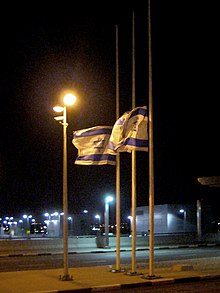Yom Hasho'a
Yom Hashoah ( Yom Hashoah ) or yom hazikaron laScho'a weLaGwura ( Hebrew יום הזיכרון לשואה ולגבורה, "Holocaust Remembrance Day and Heroism") is an Israeli national holiday and memorial day for the victims of the Shoah on the one hand and the Jewish resistance and heroism of the Jewish underground fighters on the other.
Characteristic
The 27th Nisan of the Jewish calendar was set as the day of remembrance . According to Jewish tradition, it lasts from sunset of the previous day to the following evening. If the 27th Nisan is a Friday, the day of remembrance is brought forward to the 26th Nisan; If it is a Sunday, it will be moved to Nisan 28th. Originally Nisan 14 was proposed, the date of the start of the Warsaw Ghetto uprising (April 19, 1943). However, since this is only one day before the Passover festival, the request was rejected.
The date of Yom HaSho'a was set by the Knesset on April 21, 1951 under David Ben Gurion and Yitzchak Ben Tzwi . Initially, no regulations were made regarding its design. When it became clear that the day of remembrance was hardly taken into account in public life, initiatives for a legal regulation arose. As a result, the law to commemorate the Shoah and heroism was passed by the Knesset in April 1959 and was revised again two years later, making the day a serious and national holiday since then . Exactly one week later, on the 4th of Ijjar , follows Yom HaZikaron , the “day of remembrance of the fallen Israeli soldiers and victims of terrorism”, so that the entire week in between is marked by mourning and commemoration, at least as far as the media is concerned.
For the opening ceremony on the eve of Yom HaScho'a, six torches are usually lit, symbolizing the six million Jewish victims of the Holocaust . The morning begins with memorial services in Yad Vashem . The sirens wail for two minutes throughout the country at 10 a.m. ( Hebrew צפירה Tzfira ). Local public transport and usually all other vehicles stop, most passers-by stay in silence. At the foot of the six torches in Yad Vashem, wreaths are laid by representatives of various institutions and groups of survivors.
During Yom HaScho'a, many public institutions in Israel are closed, and there are no entertainment programs on television or radio, but funeral music or documentaries about the Holocaust. All flags are flying at half mast . The prayer El male rachamim is recited at commemorative events .
Ultra-Orthodox Jews ( Charedim ) do not take part in the celebrations because the Halacha prohibits mourning days in the month of Nisan. They commemorate the Holocaust victims on traditional days of mourning that existed before the Second World War , such as Tischa beAv , on which the destruction of the temple is commemorated, or on the 10th Tevet , a day of fasting, which is also the time of year for victims of the Shoah whose date of death is unknown.
On Yom HaScho'a, thousands of mostly young Jews, especially students, conduct a memorial march from Auschwitz to Auschwitz-Birkenau . This is now referred to as the March of the Living , referring to the death marches of concentration camp prisoners .
More recently, other states or their Jewish communities have also adopted Holocaust Remembrance Day. For example, on May 3, 2005, the Jewish community held a memorial hour in Berlin . The names of the 55,696 Berlin Jews who did not survive the Holocaust were then read out. The reading lasted late into the evening until May 4th.
Yom Hasho'a in the Gregorian calendar
The date of this day varies according to the Gregorian calendar , since the Jewish calendar is always recalculated according to the moon. Even in the Jewish calendar, it does not always fall on the 27th Nisan, since days of mourning should not fall on or be adjacent to Shabbat. A Yom HaSho'ah that falls on Friday or Saturday will be brought forward to Thursday (2021 and 2025), and one that falls on Sunday will be postponed to Monday (2024). With the Gregorian dates in the table, it should be noted that the Jewish day already begins after sunset of the previous day.
| Jewish year | Gregorian date |
|---|---|
| 5781 | April 8, 2021 |
| 5782 | April 28, 2022 |
| 5783 | April 18, 2023 |
| 5784 | May 6, 2024 |
| 5785 | April 24, 2025 |
See also
- Jewish festivals
- Day of Remembrance for the Victims of National Socialism on January 27th (on the occasion of the liberation of the Auschwitz concentration camp)
- Days of Remembrance (USA)
- Holocaust (term) , why Shoa (haScho'a) and Holocaust sometimes have different meanings
literature
- Tom Segev : The Seventh Million. The Holocaust and Israel's Politics of Remembrance. Rowohlt, Reinbek b. Hamburg 1995, pp. 573-578
Web links
- Information on "haGalil"
- Standstill during the minute of silence on the autobahn. Youtube video
Individual evidence
- ↑ Segev: The Seventh Million. Reinbek b. Hamburg 1995, p. 573 ff.
- ↑ timeanddate.de
